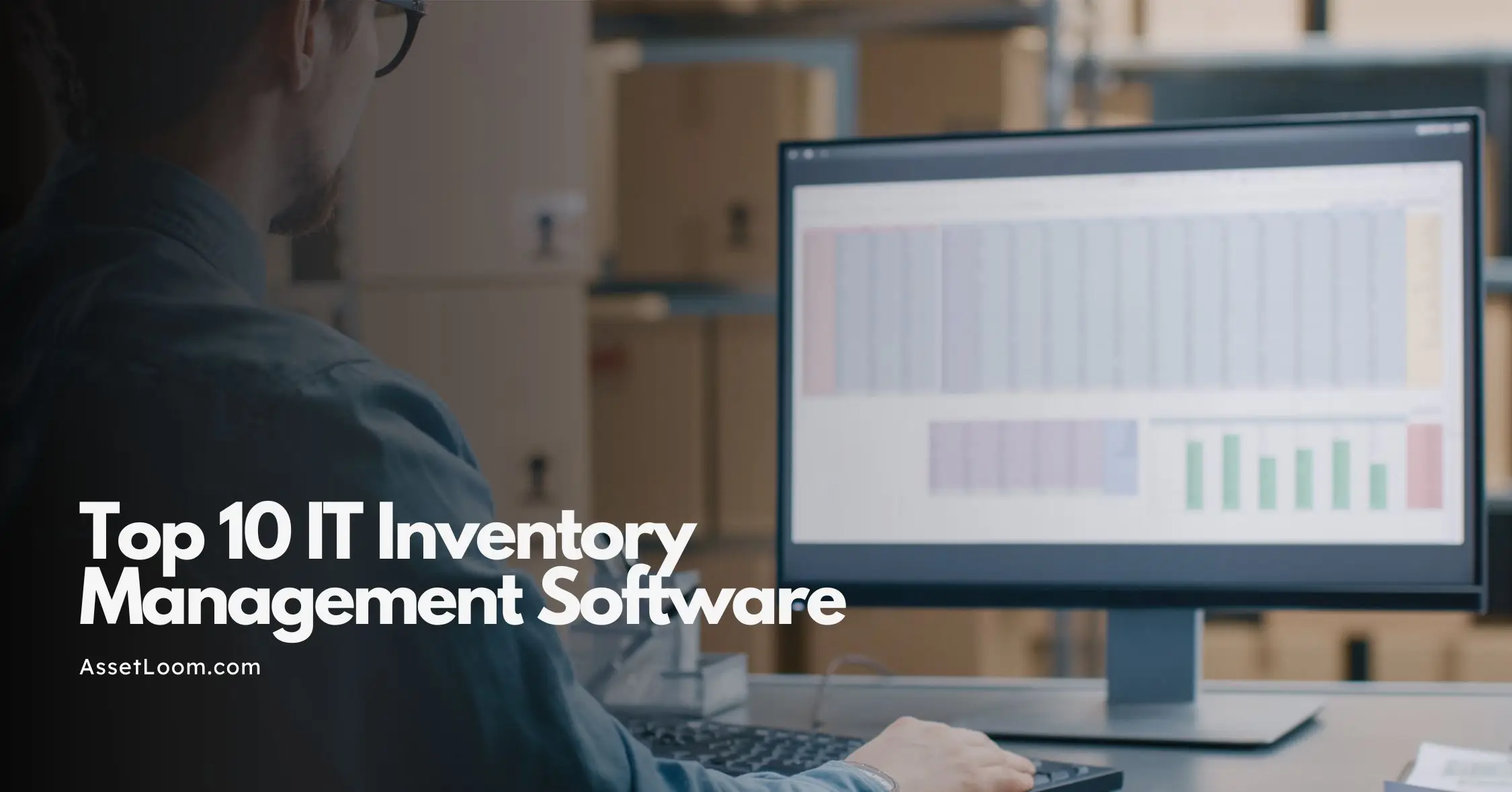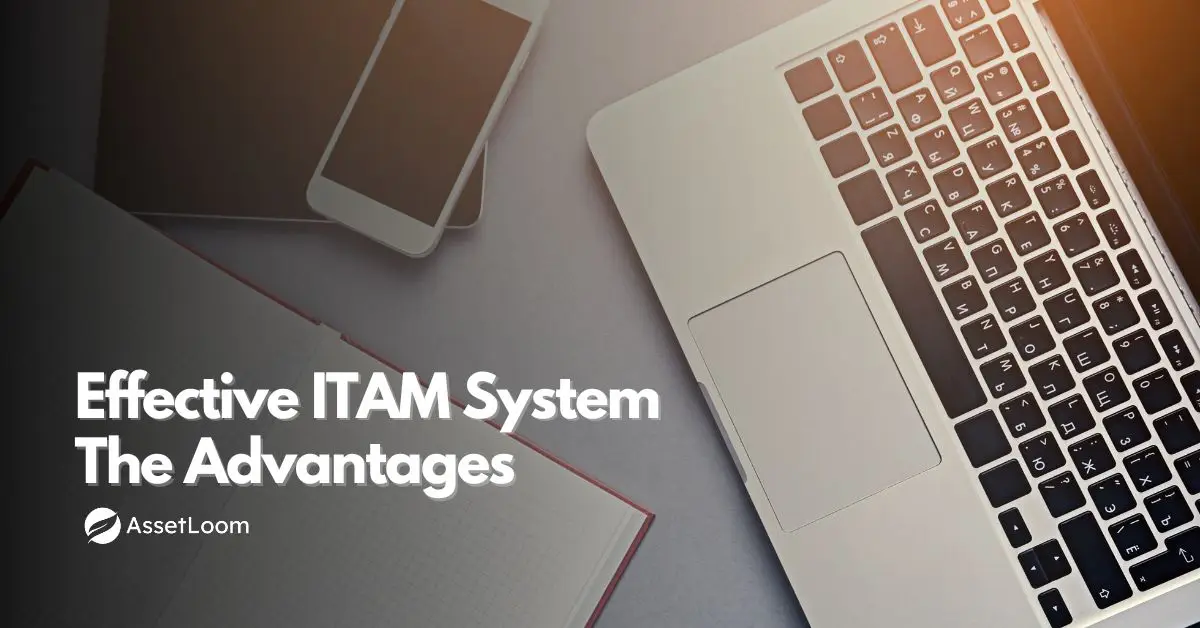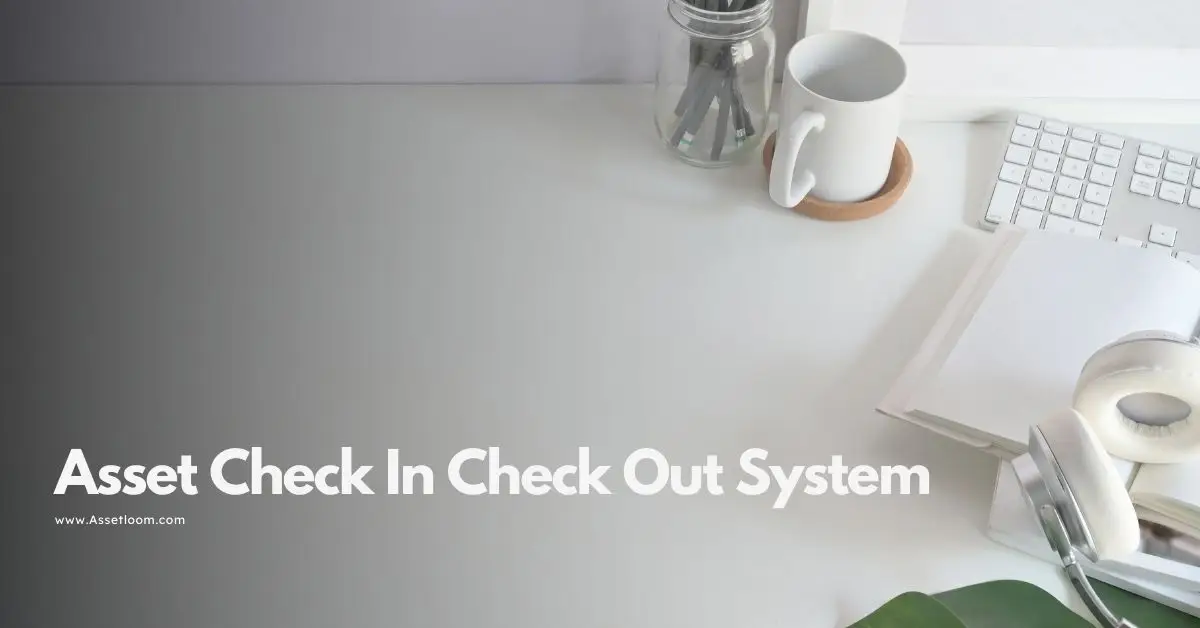IT Inventory Management: Best Practices for IT, Finance, Security
Empower IT, finance, security, and management with accurate IT inventory data. Discover IT inventory management best practices.
Organizations face growing IT asset management challenges because cloud computing and mobile devices and remote work and Internet of Things (IoT) systems continue to gain popularity. The result is a complex ecosystem of hardware and software assets that must be tracked, secured, and optimized for performance. The growing complexity of IT systems requires organizations to implement effective IT inventory management for both cost control and operational efficiency and security purposes.
This article explores best practices in IT inventory management by examining the impact of an effective IT inventory management system on each stakeholder in an organization. Therefore, we will learn how to choose the right IT inventory tools for your business.
The Impact of IT Inventory Management on Different Stakeholders
Imagine a scenario where IT professionals can instantly access detailed information about any device on the network. In the meantime, finance teams have a clear picture of IT asset costs and depreciation, while security teams can quickly identify and patch vulnerabilities. This level of visibility and control is the hallmark of effective IT inventory management.
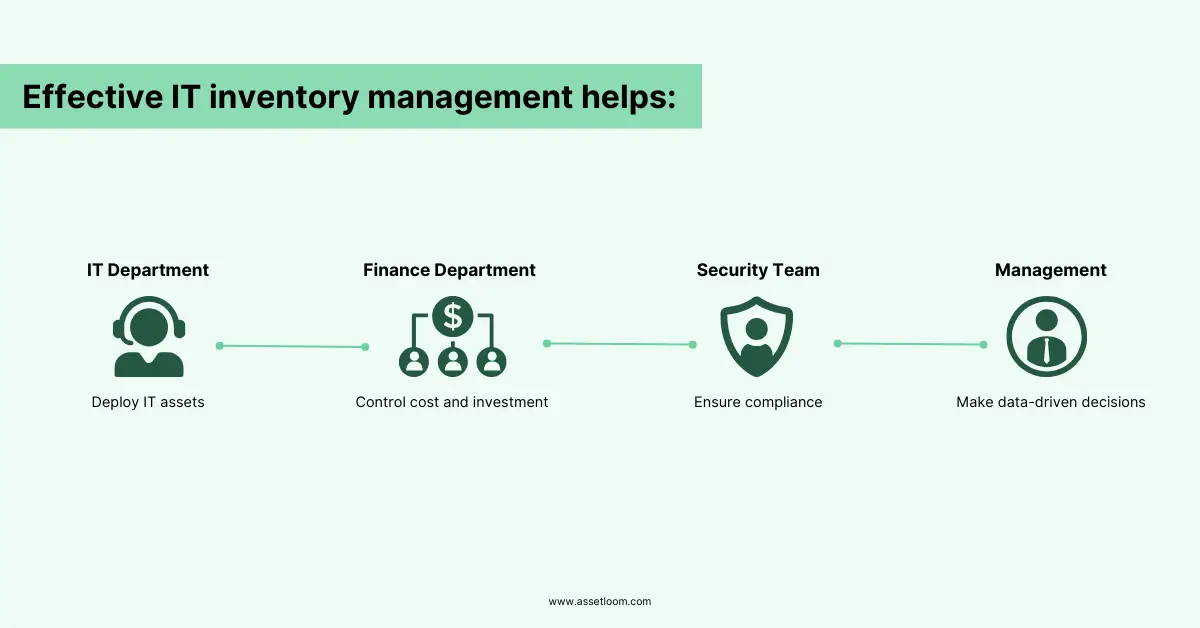
However, the benefits of IT inventory management go well beyond these apparent ones. To carry out their responsibilities efficiently, various stakeholders throughout the company depend on precise IT asset data. The remaining links will break if the first one does. Let’s break down the roles of IT, finance, security, and management teams, then demonstrate how a well-managed IT inventory is essential for organizational success.
IT Department: The Backbone
IT specialists are in charge of installing software, maintaining security, troubleshooting problems, and keeping the lights on. Overwhelming workloads are frequently caused by inaccurate data tracking and a lack of visibility. This leads to:
- Slow Troubleshooting: Technicians waste valuable time searching for asset information.
- Security flaws: Unpatched or unfamiliar devices give hackers a point of entry.
- Problems with Software License Compliance: Penalties may arise from excessive spending or inadequate licensing.
- Challenge Handling BYOD: Monitoring staff-owned gadgets introduces an additional level of difficulty.
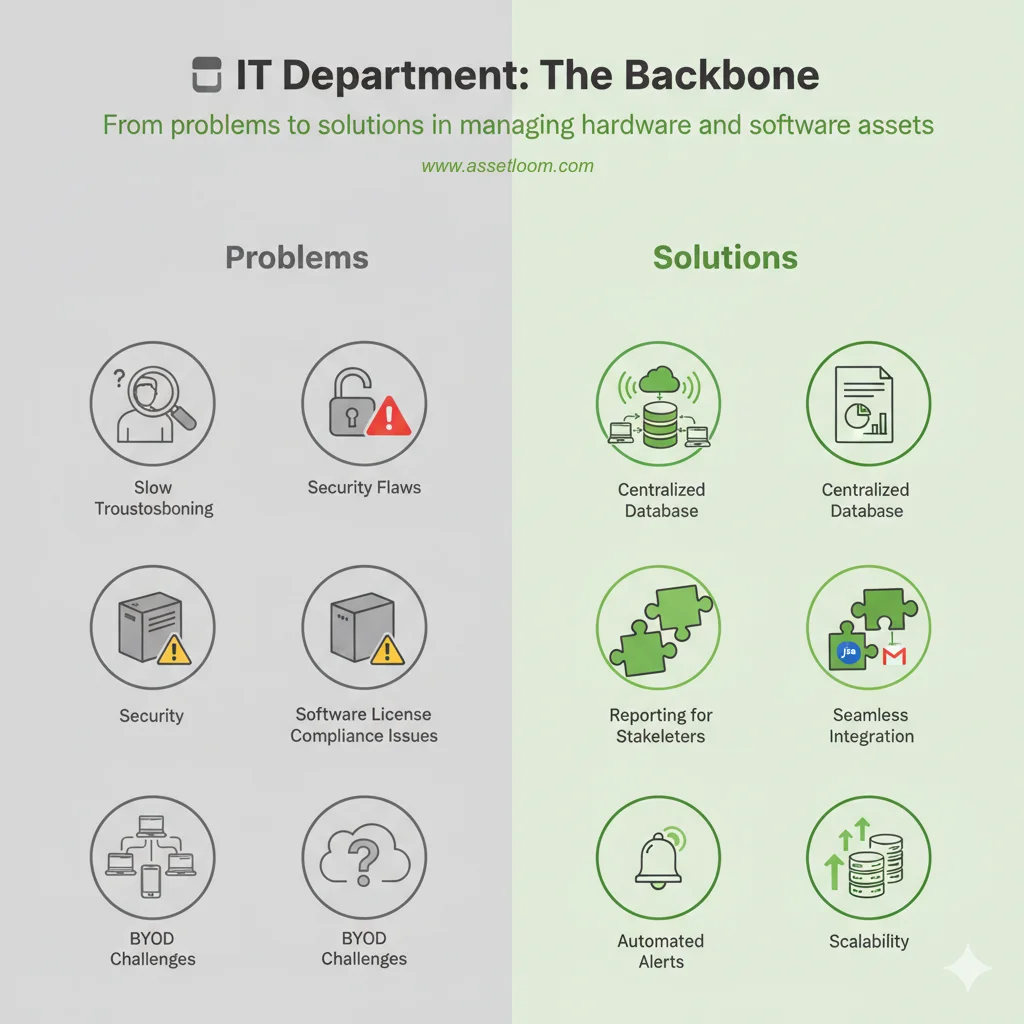
Good IT inventory management, in the context of an IT inventory tracking software, offers solutions:
- Automated Discovery enables organizations to save time and achieve precise results by automatically discovering and recording all hardware and software assets across their network infrastructure.
- The system maintains all IT assets, including hardware and software and cloud resources within a single centralized database.
- The system enables users to generate reports that fulfill the information needs of different stakeholders including IT personnel and financial teams and security teams.
- The system enables seamless integration with existing tools, including Jira Service Desk and Gmail to enhance the IT inventory workflow.
- The system provides automated alerts that notify users about inventory shortages and upcoming warranty expiration dates and approaching compliance deadlines.
- Choose a tool that offers scalability features to support expanding resources and technological developments as your organization grows.
Finance Division: Managing Expenses and Investments
Budgeting, cost management, and optimizing return on investment are the main concerns of finance teams. Using inaccurate IT inventory data can result in:
- Overspending on pointless hardware or licenses is an example of inaccurate budgeting.
- Challenge Monitoring Asset Value: Insufficient insight into the lifecycle and depreciation of assets.
- Noncompliance with software licensing agreements poses a risk to compliance.
The following advantages come from efficient IT inventory management:
- Cost tracking: Comprehensive data on the total cost of ownership, depreciation, and asset costs for both hardware and software assets, giving finance teams complete visibility into IT spending.
- Monitoring license usage, guaranteeing adherence, and preventing expensive fines are all part of license management.
- Budgeting: Precise information for estimating and allocating IT spending.
- ROI tracking: Proving the worth of IT expenditures and defending additional expenditures.
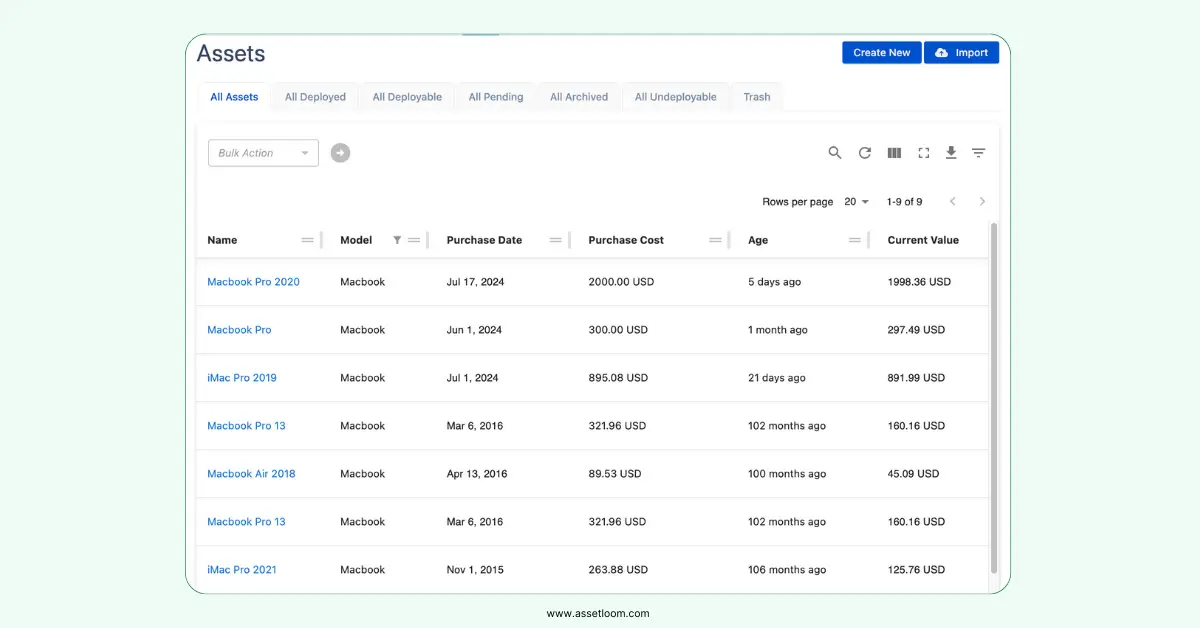
AssetLoom helps calculate the depreciation of an asset over time, based on the straight-line formula.
Security Team: Reducing Hazards and Guaranteeing Adherence
Security teams are in charge of guarding private information and stopping online attacks. Poor IT inventory management makes their job significantly harder with:
- Difficulty Identifying Vulnerable Devices: Unpatched or unknown hardware and software assets increase the attack surface and present a serious security risk.
- Expanded Attack Surface: The potential attack surface is increased by unmanaged devices.
- Compliance Violations: Noncompliance with data privacy laws and industry regulations.
Robust IT inventory software empowers security teams with:
- Vulnerability Scanning: Prioritizing and identifying security flaws is made easier by integration with vulnerability scanners.
- Detecting Unauthorized Software: Stopping the use of dangerous or unapproved software.
- Security Audit Trails: Facilitating quicker incident response by monitoring modifications to asset configurations and access.
- Compliance Reporting: Producing reports for audits of regulatory compliance.
Management: Taking Action and Promoting Development
For management to make well-informed decisions regarding IT investments and resource allocation, accurate data is essential. Ineffective inventory control in IT can result in:
- Using outdated or insufficient information to inform strategic decisions is known as "inaccurate data for decision-making.
- Budget waste on underutilized or superfluous assets is known as inefficient resource allocation.
- Challenge Measuring IT Performance: Insufficient insight into how well IT investments are working.
Good IT inventory management provides management with:
- Real-time Visibility: Current data on IT assets and their performance is available through dashboards and reports.
- guarantee Enabling well-informed choices regarding resource allocation and IT investments.
- Better management and supervision of IT resources that guarantee alignment with corporate objectives is known as improved IT governance.
- Integrating IT resources with the overarching business plan is known as strategic planning.
Practical Best Practices for IT Inventory Management
A strategic approach that necessitates meticulous planning, execution, and continuous improvement, effective IT inventory management is more than just a list of chores. The following are important best practices to think about:
1. Choose the Right IT Inventory Tool
Choosing the appropriate software is the cornerstone of efficient IT inventory management. The size, complexity, and objectives of your company should all be taken into consideration when choosing a tool. These are the main characteristics to search for.
- Automated Discovery: A must-have feature that enables automatically discovering hardware and software assets across your entire IT environment, saving time and ensuring accuracy.
- Centralized Database: Maintain a single source of truth for all IT assets, including hardware, software, and cloud resources.
- Customizable Reporting: Generate tailored reports to meet the needs of different stakeholders (IT, finance, security, etc.).
- Integration Capabilities: Seamlessly connect with existing tools that streamline the IT inventory workflow (e.g. Jira Service Desk, Gmail).
- Alert and Notification System: Receive proactive alerts for low stock, expiring warranties, or compliance deadlines.
- Scalability: Choose a tool that can grow with your organization, accommodating new assets and technologies.
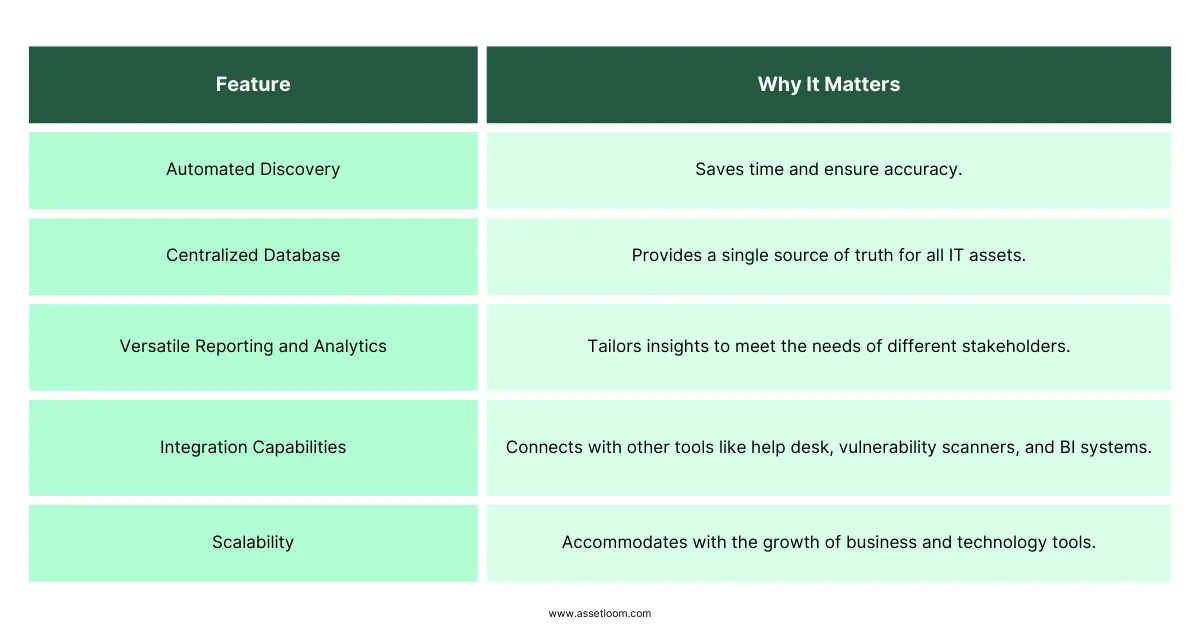
What Makes It Important? By simplifying procedures, reducing manual labor, and generating actionable insights, an efficient tool enables teams to focus on strategic goals rather than administrative tasks.
In each of these domains, AssetLoom shines, providing a strong solution tailored to each team's requirements inside your company.
2. Embrace Automation
Manual inventory tracking is unsustainable, time-consuming, and prone to errors. Whenever possible, embrace automation. This comprises:
- Automated Discovery: To automatically find and catalog all connected hardware and software assets, use agent-based discovery and network scanning tools that simplify ongoing inventory tracking.
- Automated Data Collection: To automatically fill the inventory database, integrate with procurement systems and other data sources.
- Automated Alerts: Configure alerts for important occasions like low inventory, lapsed warranties, or possible security flaws.
Quick Tip: Select a tool that automates asset data collection, IT network discovery, and critical event notifications to save even more time and effort.
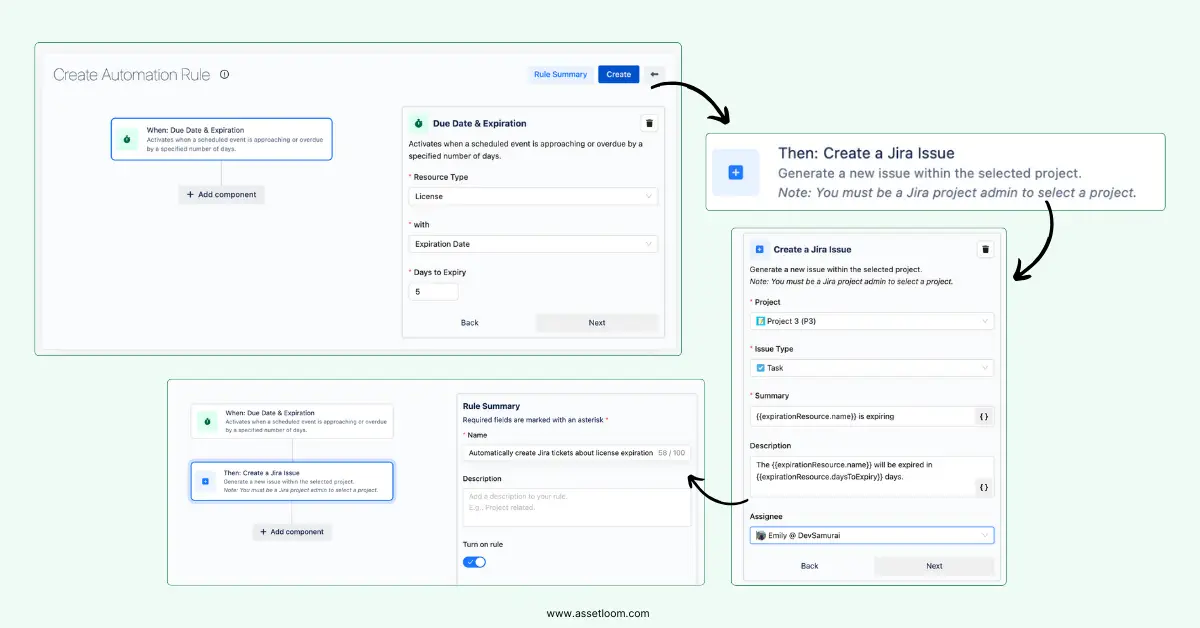
Automation rule in AssetLoom
3. Don’t Overlook The Asset Lifecycle
As part of the ITAM process, don’t forget to monitor hardware and software assets at every point of their lifecycle, from purchase to disposal. Pay attention to warranties, maintenance schedules, and end-of-life dates to optimize asset utilization and avoid unnecessary costs. Lifecycle management reduces waste, maximizes return on investment, and ensures compliance with disposal regulations.
How Automated Discovery Transforms Inventory Accuracy
Keeping an accurate record of IT assets is a challenge when it depends on manual updates. Spreadsheets and separate logs often lead to missing entries, repeated records, or outdated details. These mistakes make it hard for teams to know which devices are active and which software licenses are still in use.
Automated discovery solves this by scanning the network and automatically discovering hardware and software assets. Each time a device or application connects, the system adds it to the inventory right away. This keeps the database current and reliable.
The results are clear:
- Fewer Errors: No need for manual input that can cause mistakes.
- Better Visibility: All devices and applications are included, even ones that are easy to overlook.
- Audit Ready: Records stay accurate for compliance and license checks.
- Quicker Fixes: IT staff can find the right asset details in seconds.
With automated discovery, the inventory grows and updates along with the organization, giving every team a dependable view of the assets they manage.
Common Challenges in IT Inventory Management
Managing IT assets is not just about keeping a list of devices. In many companies, it brings up everyday issues that slow teams down. Here are some of the most common ones, along with examples:
- Shadow IT: Employees often install free tools or use cloud apps that the IT team never approved. For example, a marketing team might sign up for a design app on their own. The app could hold company data, but since it’s not recorded, IT has no control or visibility. This creates security and compliance risks.
- Cloud Complexity: Many organizations now rely on dozens of cloud services. A company might have Microsoft 365, Google Workspace, project tools, and several SaaS apps. Tracking costs and usage for each one is difficult, especially when subscriptions renew automatically.
- BYOD (Bring Your Own Device): It’s common for staff to use their own laptops or smartphones for work. While convenient, this makes inventory harder to manage. For example, an employee might have sensitive files on a personal laptop that isn’t listed in the asset database, leaving security gaps.
- Data Silos: Different departments sometimes keep their own records of hardware and software. The finance team might track purchases, while IT keeps a separate list for troubleshooting. If these records don’t match, it’s hard to know the true number of assets or their current state.
- Inaccurate Data: Assets are constantly changing — laptops get replaced, servers are upgraded, and software licenses expire. If updates are missed, the inventory quickly becomes unreliable. For example, if a server is retired but still listed as active, it may skew budgeting and compliance reports.
Conclusion
Modern businesses now require effective IT inventory management; it is no longer an option. AssetLoom helps businesses make data-driven decisions, cut expenses, and streamline operations by catering to the unique requirements and problems of management, finance, security, and IT teams.
-------
Frequently Asked Questions
1. What is IT inventory management?
The process of monitoring and controlling all of an organization's IT assets, such as software (licenses, applications), hardware (computers, servers, network devices), and other digital resources (cloud subscriptions, virtual machines), is known as IT inventory management. Knowing what IT resources you have, where they are, who is using them, and their current state is essential. As a result, you can ensure cost control, security, compliance, and strategic planning by streamlining your operations.
2. What are the risks of poor IT inventory management?
Ineffective inventory control in IT can result in:
- Wasted time troubleshooting problems or looking for assets.
- Devices that are not patched or monitored are increasingly being targeted by cybercriminals.
- overspending on hardware or licenses that aren't needed.
- penalties for not adhering to software licensing or regulatory requirements.
- Strategic planning and resource allocation are hampered by inaccurate data.
3. What are the essential features to look for in IT inventory management software?
Key features include:
- Automated Discovery: Automatically identifies and catalogs IT assets across the network.
- Centralized Database: Stores all asset information in a single, accessible location.
- Asset Lifecycle Management: Tracks assets from procurement to disposal.
- Reporting and Analytics: Generates reports and dashboards for insights into asset usage and performance.
- Integration Capabilities: Connects with other IT systems (help desk, procurement, security).

Subscribe for Expert Tips and Updates
Receive the latest news from AssetLoom, right in your inbox.
